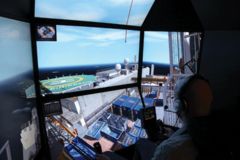 Crane simulators allow operators to experience a range of challenging conditions in one day that could take many years in the workplace. Euan Youdale talks to Arnold Free, CMLabs chief operating officer, about the simulator market
Crane simulators allow operators to experience a range of challenging conditions in one day that could take many years in the workplace. Euan Youdale talks to Arnold Free, CMLabs chief operating officer, about the simulator market
Based in Canada, CMLabs produces simulators, under the Vortex brand name, for application across the industry, in construction, offshore, dockside and industry. Simulated machines range from mobile to tower cranes, offshore knuckle booms to platform and ship cranes, and overheads to pick and carry cranes.
High wind, blind lifts, tandem lifts with two simulators and engineered heavy lifts can all be experienced. Simulators also help build quick reactions and experience with the unexpected: a sling break, high wind gust or outrigger failure.
Euan Youdale: How has crane simulation developed over recent years and why?
Arnold Free: Crane simulators have been used for operator training since the mid-1990s. Early simulators did not have very realistic graphics and the simulation of the crane and load dynamics was poor. In addition, training content was really limited to basic control familiarisation and understanding basic operating procedures. Today there is a wide range of simulator products available, from simplistic desktop ‘crane games’ to very immersive high-fidelity simulators. Cost for crane simulator solutions varies from several thousand dollars to many hudreds of thousands.
EY: How has the technology progressed to enable this?
AF: The improvements in low-cost computing power and 3D graphics have made the technology more accessible. Simulators that cost close to US$1 million 10 to 15 years ago can be built for half or a third of that cost today. In addition, there has been considerable progress in software technology to build simulations. Tools like Vortex, a commercial software development toolkit to build equipment simulators, allow software developers to accurately simulate the dynamics of heavy equipment and hoisting systems with off-the-shelf solutions. That challenge in delivering high quality simulation-based training is moving from a technical challenge to one of a training and learning content development challenge – building effective training).
EY: How will technology allow the development of simulators in the future?
AF: The quality of the simulation – visual and fidelity of dynamics – will continue to improve as will the training content for real skills development. More integrated training is becoming available: team based training, integrated maintenance, rigger, equipment training.
EY: How will simulators’ offerings expand in the future?
AF: One area we see a growing interest is in team-training; it is simply not good enough to only train the operator. Lift operations is team work and it is essential to train the operator, signalman and rigger to work together. In the case of tandem lifts, or engineered lifts, such as wind turbine erection, not only do team members need to work together but more than one piece of equipment needs to work together as well. Building immersive simulation-based training for the entire lift team is not only possible, we have implemented it at training institutes today. Team work cannot be taught in a class room, and a simulated multi-player training environment is the ideal solution to build team work before the lift crew is on the worksite.
We also see a growing need to train operators in specific equipment with the integration of OEM control systems. In the past, simulator suppliers have tended to mimic control systems for cranes. However, cranes are becoming more-and-more complex to operate. The skills operators need is moving from basic hand-eye coordination to become systems managers as the computer systems on board cranes becomes more and more complex.
EY: How do simulators tie up with certification and training bodies?
AF: In the construction industry we have incorporated certification tests within the training exercises. Operators can practice standard tests such as the NCCCO [National Commission for the Certification of Operators] tests using different types and sizes of cranes. Procedures such as start-up tasks, pre-lift inspection and deployment of outriggers are all incorporated so students can learn safe operating procedures that reflect the current standards.
In the offshore industry we have adopted guidelines from OMHEC [Offshore Mechanical Handling Equipment Committee] for operator, signalman and rigger training in a team-based learning context. Vortex simulators are in use at many training institutes and those organisations have very much influenced the training content within the exercises.
We also see simulation being used for certification and re-certification more and more. For example, North Sea crane operators must be recertified every three years. This recertification can be done using simulators. The role and use of simulation will continue to grow – in some areas we are even building simulation-based training directly into the actual equipment so operators can perform training in the equipment seat during downtime.
EY: Are there developments in training people who work outside the cab?
AF: We see a lot of interest in the use of simulation for lift planning. There is a growing need to simulate engineered lifts in advance, by an engineer or lift specialist in a desktop application context. Essentially providing a 3D environment where an engineer can select a crane, define the load and lifting conditions and actually perform the lift virtually.
This type of tool can be used to evaluate equipment performance, site safety and even as input to training site operators on how a lift will be performed. We have been doing quite a bit of this work in the offshore industry related to subsea lift. Using simulation at the planning stage allows companies to reduce project risk, evaluate alternatives to reduce cost and improve safety. To date this has largely been driven by the offshore industry due to the complexities and high cost of operations and safety issues related to deep water subsea and heavy lifts.
Source:

